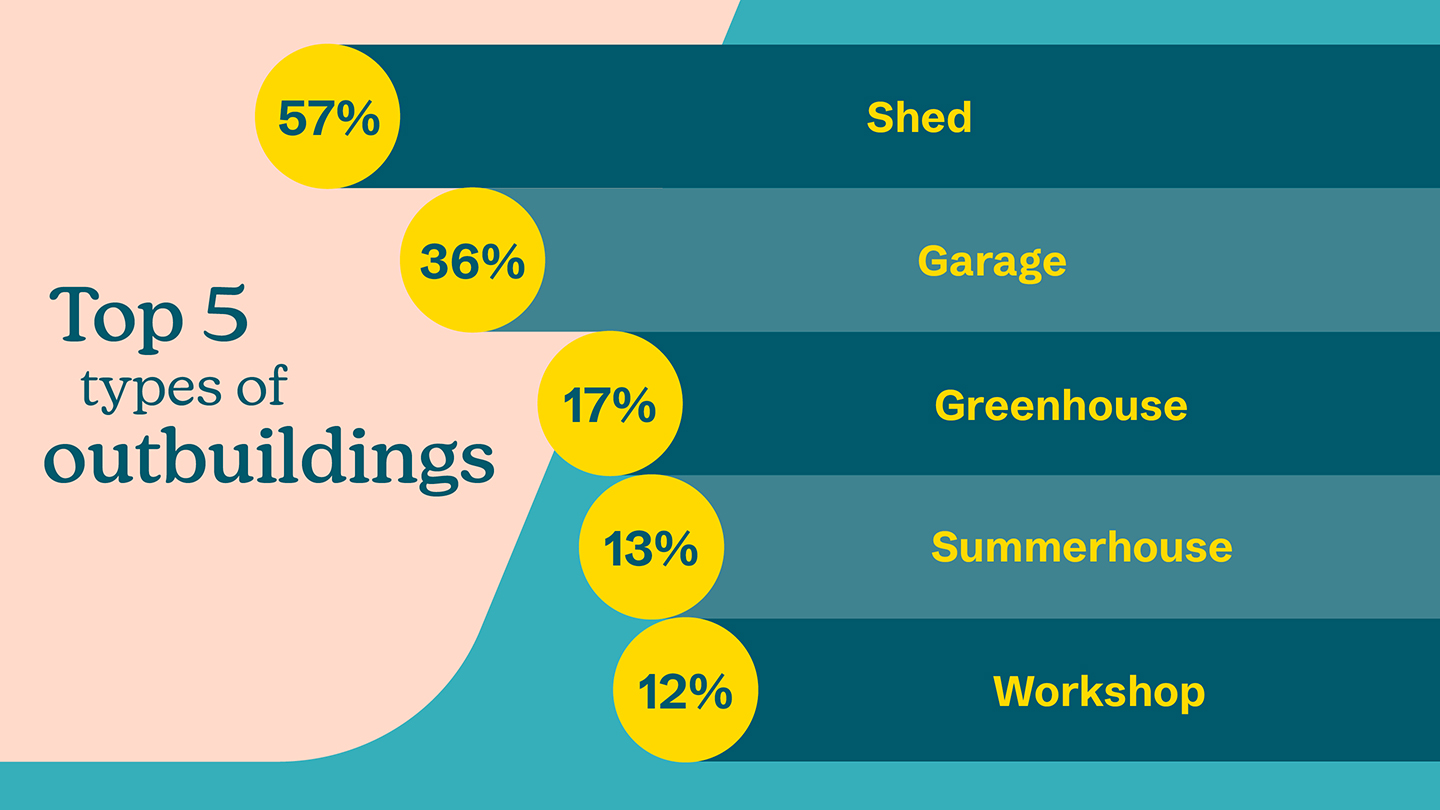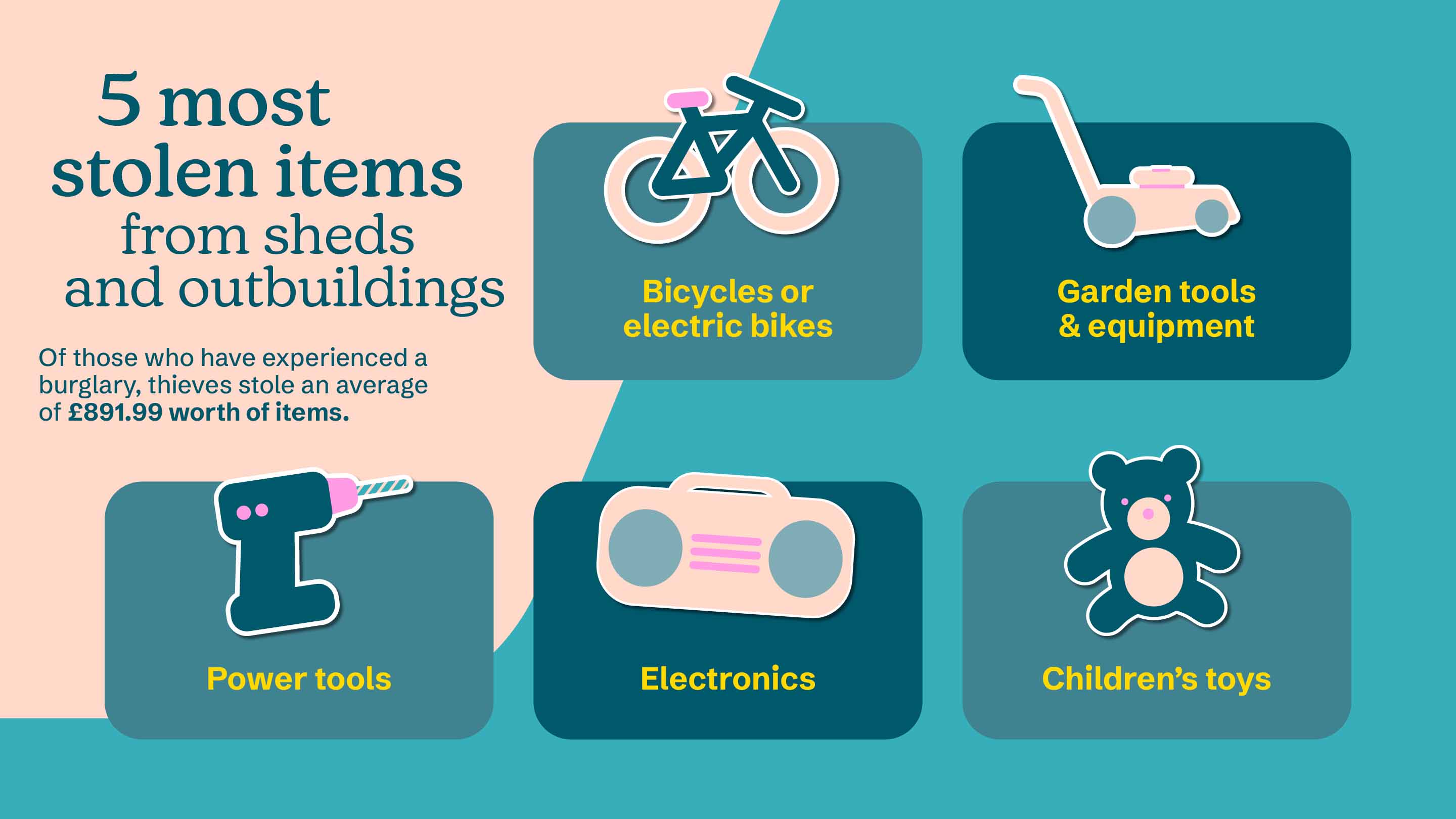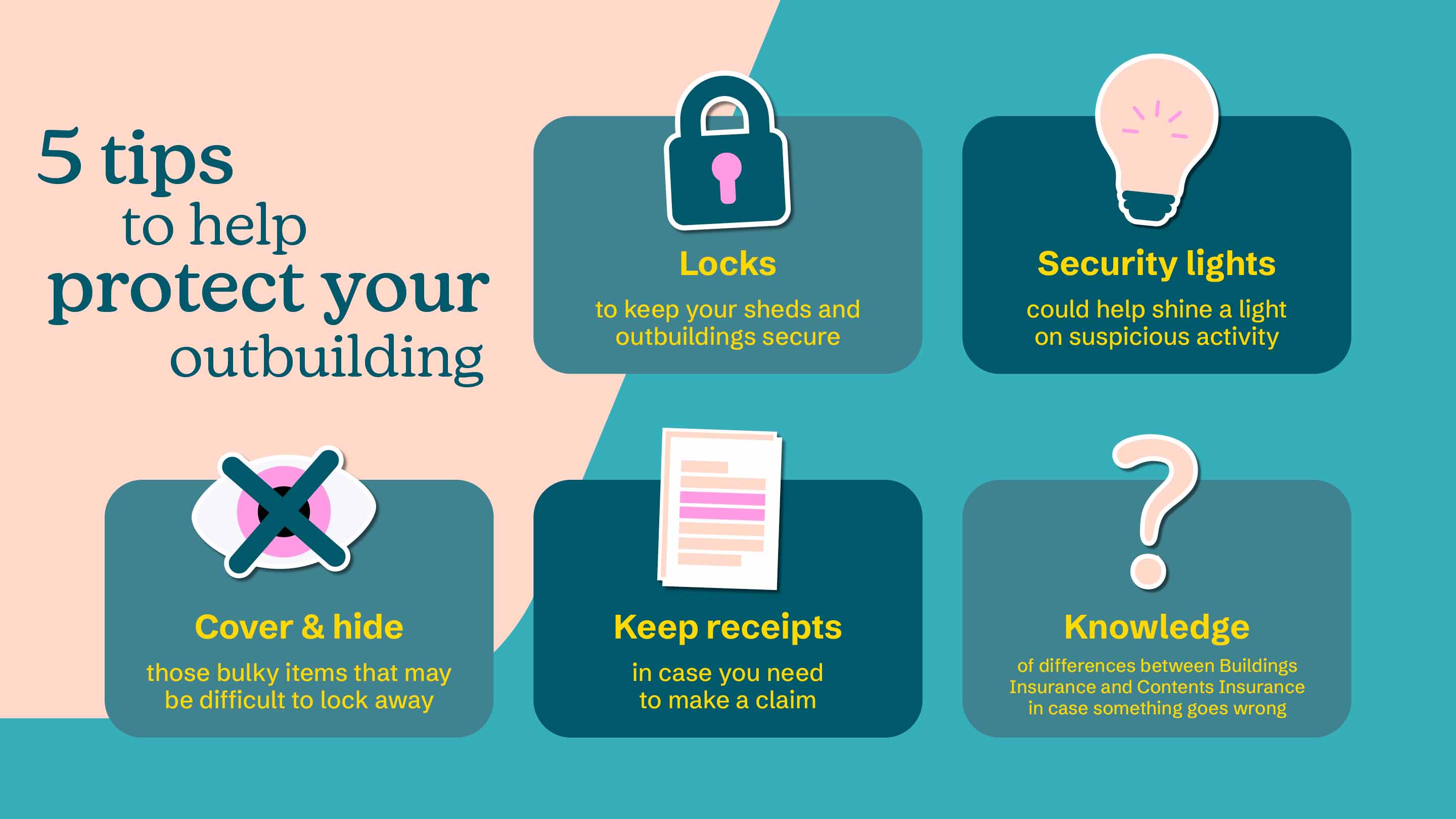Protect your shed from burglars
Whether it’s your shed or garage, here are some ways to help protect your outbuilding from burglars.

From the family bikes and scooters to your power tools and garden furniture, your shed may have things you chuck in and forget about until you need them.
Almost three quarters of Brits, in our recent survey of 2,024 people in the UK, have at least one shed or outbuilding. Footnote [1] Although the things held in your shed or outhouse may be out of sight and mind, it's important to help keep them safe throughout the year.
Of those surveyed, 1,500 people have a shed or outbuilding. The top five types they own are:Footnote [1]
- shed (57%)
- garage (36%)
- greenhouse (17%)
- summerhouse (13%)
- workshop (12%)

So, when it’s time to grab the trowel and gloves to sort out the garden, let’s make sure they’re ready and waiting for you.
What is an outbuilding?
Our survey described an outbuilding as, “permanent and immovable structures, that are within the boundaries of your home address, and are not lived in. For example, sheds, summerhouses, garages.”
What do people use their outbuildings for?
Those surveyed primarily use their shed or outbuildings to store the items they use outdoors, like gardening tools and outdoor furniture. They’re also used to store:
- items that won’t fit in the house
- items that are on their way to being sold or dumped
- some type of vehicle.
You’ll also likely find:
- a bicycle or electric bike
- seasonal decorations
- camping equipment
- gym or exercise equipment
- sports or hobby equipment (skis, golf clubs, telescopes, fishing gear)
- kids toys.
Some Brits also use the space for a workshop, a place to workout, or a hobby space (like painting). Those aged 25-34, in our survey, are most likely to use their outhouse as a games room, an office, or as a space to store a vehicle.
And while women are seemingly more likely to keep garden tools and equipment, outdoor furniture, and power tools in their outbuilding, men may be more likely to have a car, camping equipment, or gym (exercise) equipment in theirs.
Are outbuildings at risk of burglary?
This largely depends on the security measures you take.
Nearly half of those surveyed secure their outbuilding with a lock and key, almost one third use a padlock and hasp, and close to a quarter use a security camera.
Yet, 29% of those surveyed experienced a break in, or attempted break in, to their outbuilding. And of those, 44% were at home when this happened. More striking is that more than two thirds of those who had a break in, or attempted break in, to their outbuiling said the burglars also attempted to break in, or successfully broke in, to their home at the same time. Footnote [2] So, if sheds and outbuildings may be vulnerable to thieves, it’s worth exploring how to help secure them.
One in eight of those surveyed admit they don’t take any security measures to protect their outbuilding. And significantly fewer than half always make sure their shed or outbuilding is locked before:
- going on holiday or away from home for more than one day (38%)
- leaving the house (37%)
- before going to bed (37%).
One in six of those surveyed said they usually don’t lock their shed or outbuildings when mowing the lawn, gardening or doing other outdoor chores with around one in ten usually keeping them unlocked if they’re home. And you might wonder who would be so bold as to steal while you’re mowing the lawn or cleaning the gutters, but burglars could see that as an opportunity.
“We tend to think,” says Hazel Johnson, Director of Home and Motor Claims at Aviva, “that burglaries happen when everyone is out of the house, but burglars can strike at any time, including when we’re at home. This doesn’t mean you should be alarmed or live in worry. It simply means that building good habits around securing your outbuilding is worthwhile.”
What are the most stolen items?
Of those who experienced a break-in (or an attempted one), nearly two in five of these were of a shed, almost a third were of a garage and nearly a quarter were of a workshop. And one in six of those surveyed admit to regularly keeping valuable items in their shed or outbuilding.
The most stolen items from sheds and outbuildings include:
- bicycles or electric bikes
- garden tools and equipment, such as lawnmowers
- power tools
- electronics, such as a computer, speakers or radio.
- children's toys.
Of those who experienced a burglary, thieves stole (on average) £891.99 worth of items. Footnote [3]

How can people help keep their outbuildings secure?
“Our research,” says Johnson, “shows that burglary from sheds and outbuildings could not only mean a significant financial loss, but may also increase the risk of home burglary. In more than two thirds of cases, burglars also attempted to break in or broke into the home.”
Five tips to help protect your shed or outbuilding:
- Locks – make sure to lock your sheds and outbuildings, including when you’re at home. This also means replacing any rusty padlocks, as they’re easier to bash open.
- Security lights – installing security or motion-activated lights near outbuildings could help shine a light on suspicious activity and send a message to burglars to buzz off.
- Cover and hide – for those bulky items that may be difficult to lock away (barbeque, fire pits, and garden furniture), cover them and try to place them in a secure area.
- Keep the receipts – in case you need to make a claim, and let’s hope that doesn’t happen, having receipts for any high-value items could make the claims process easier.
- Knowledge – Knowing the difference between your Buildings Insurance and Contents Insurance can help you in case something goes wrong. While Buildings Insurance covers damage to structural parts of your shed or outbuilding, Contents Insurance covers moveable items like your garden furniture, plant pots and garden tools. Remember, most standard home insurance policies include limited cover for your garden and its items.
It’s also worth checking your single item limit within your home insurance policy, especially if you have any high-value items, like a top-of-the-range barbecue or luxury garden furniture, stored in your shed or outbuilding. You may need to separately list any items above the limit in your policy.
Also remember that the total sum insured in sheds and outbuildings is often lower than the main home, so be mindful of what you store there.
Building these safety habits means you can be more confident in finding your barbeque and fire pit where you’d expect them, ready for the next big garden party.

What to do if your outbuilding has been burgled
“It’s certainly distressing to find out you’ve been burgled,” says Johnson, “and it’s entirely reasonable to feel shaken up or overwhelmed by the experience. Remember, what’s important is that you and your family are safe, so the first step is to remain calm. Find a space that is safe and, once the shock settles, you can prioritise next steps.”
Step 1: Don’t touch a thing
This could be difficult as, quite naturally, you’ll want to sort through your things to see what’s missing. But until your home is checked by the police, you'll be better placed to leave everything as it is, until you're out of the house.
Step 2: Leave the space
Walking into your outbuilding or shed to see it’s been burgled can be devastating. But your safety, as well as that of your family, is better served by leaving that space right away. Find a safe place to wait and call 101 to report the burglary. If you think the intruder(s) may still be around, then call 999. Make note of any unusual or suspicious activity as you wait for the police to arrive.
Step 3: Take stock
Once you have permission from the police, start taking inventory by making a list of what’s been stolen with an estimate of how much each item costs. This will not only help the police, but also your insurer. Take pictures of any damage (inside and out) caused by the burglary.
Step 4: Chat with your insurer
Check your policy information because some insurers ask that you get in contact within 24 hours of the burglary. They may ask for:
- the name and address of anyone who may have witnessed the burglary
- any suspicious activity before or after the robbery
- the police report that details the incident.
Step 5: Clean up
Once your outbuilding is fully inspected and reports taken by the police, you may want to clean up the mess or damage caused by the burglary. As this may be overwhelming, reach out to family and friends who may help you through this process.
To learn more, check out our insights and tips to help prevent burglaries in the UK.



